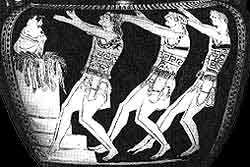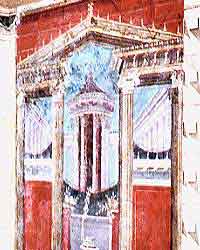
a ghost rising from a tomb and a chorus of warriors

a wall painting that gives an idea of tragic scenery
| The skene, or scene building, that faced the audience from the other side of the orchestra was the principal scenic element. Most tragedies require the skene building to represent either a temple or a palace. The skene had one central door way and at some point by the early 4th century B. C., acquired two flanking ones. Many skenae, including the one in the Theatre of Dionysos in Athens, had projecting wings, or paraskenia. A row of columns between the paraskenia supported the stage or logeion. These columns were called the proskenion. Large openings between the three doors of the skene were called thyromata. These were used to display scene painting which were often by famous artists. In later periods the scenery revolved on a three-sided axel called a periaktos. Scenerey could be changed during a performance if it was desireable to do so. Some tragedies in the classical period did require a change of setting as does The Persians which has three places: the steps of the boule or assembly hall in Susa, the tomb of Darius near Persepolis, and the royal road to Susa. It is doubtful that the theatre of 472 B.C. had any means to change the scenery literally before the eyes of the spectators. However, special set peices could be introduced to make the set more literal, the rock to which Prometheus is tied, and the tomb of Darius are examples. The tomb may have looked like an altar as in the picture on this page. The theatre also was equipped with machinery for stage effects, notably the ekkyklema, a platform that slid out from the central door of the skene to reveal interior scenes, in tragedy often of murder and mayhem, and the machine, a crane to similate flight by the gods or human characters like Bellerophon and Medea. The literary expression,deus ex machina, or god from the machine, comes from the theatrical use of this device |
a ghost rising from a tomb and a chorus of warriors |
a wall painting that gives an idea of tragic scenery
|